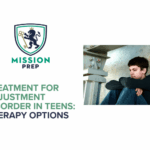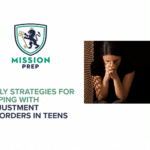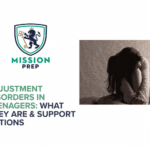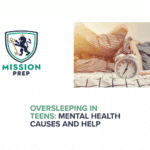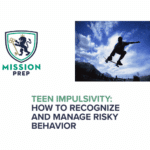Teen Codependency: Recognizing Patterns and Supporting Independence

The definition of codependency has evolved over the years based on different research focuses. Originally, the term “codependency” was developed to describe relationship dysfunction related to substance abuse issues.1 Specifically, these relationships were centered around trying to control a spouse’s drinking behavior or drug use in an effort to protect or change them.1 However, we’ve now come to realize that codependent relationships can come about from other life stressors and internal factors.
Teen codependency is an issue gaining attention recently because it can apply to many different interpersonal relationships, including those with parents, friends, and romantic partners.
If you’re concerned about patterns of codependency in your teen, a mental health professional can provide clarity and guidance. This page can also help you better understand teen codependency by discussing:
- What teen codependency is
- Causes of codependent behavior in adolescence
- Recognizing unhealthy patterns in relationships
- Therapy for codependency
- Parental guidance for independence in teens
- Where to find professional support

Defining Codependency
Codependency alone is not a psychiatric disorder, but rather a set of dysfunctional behaviors that drive an unhealthy relationship.2 In a codependent relationship, someone has problems setting appropriate boundaries, and it is believed that this difficulty has to do with an exaggerated empathic response.
Essentially, someone who is codependent fears that the other person in the relationship will come to harm. Therefore, to stop this from happening, they act in ways they believe will help the other person – however, they typically end up harming themself.2
Some of the key characteristics of codependency, according to past research, are:2
- Caretaking
- Low self-worth
- Repression of feelings
- Obsessing over actions or thoughts
- Attempting to control
- Denial
- Poor communication
- Weak (personal) boundaries
- Lack of trust in self and others
The problem with this list is that the characteristics are vague and difficult to objectively measure. Therefore, another model of codependency suggests there are five main symptoms. These are difficulties with…2
- Experiencing appropriate levels of self-esteem
- Setting functional boundaries
- Owning one’s own reality
- Acknowledging and meeting one’s own needs and wants
- Avoiding extreme emotions
Again, because these features can be generalized to include almost any relationship if you try hard enough, this definition of codependency may still be hard to illustrate.
For this reason, for the sake of this article, we’ll consider one specific type of codependent relationship. One that involves enabling a negative behavior that further perpetuates the vicious cycle of a dysfunctional relationship.2
Causes of Codependent Behavior in Adolescence
There are several proposed causes of codependent behavior in adolescence, including parenting styles,3 family stressors,1 and personality traits.1
Based on attachment theory, the way parents interact with their child early on can have a large impact on an adolescent’s codependent behaviors3. This is because insecure attachment styles in parenting, like anxious attachment or disorganized attachment, can lead children to seek external validation and rely heavily on others in a relationship.3
Additionally, children who grow up in families with environmental stress report higher rates of codependency and other social and interpersonal symptoms.1 This stress may involve parental substance misuse, mental health conditions, or physical illness. Further, other dysfunctional family dynamics like abuse, neglect, and enabling behaviors are associated with higher rates of adolescent codependency.3 The theory behind these factors is that a child may take on the role of caretaker and learn to prioritize others’ needs above their own to survive.
When emotions are volatile or communication is poor in the home, this may also increase the risk of children developing codependent behaviors. In such cases, adolescents might look to others outside the family to rely on for support.3 Therefore, they may seek physical and emotional safety through codependent behaviors. Even if this relationship is dysfunctional, the child might have learned that they need this person to protect them.3
Finally, certain personality traits can make someone more susceptible to developing codependent relationships. For example, adolescents with low self-esteem, anxiety, and depression score higher on codependency rating scales.1
Studies show that stable personality traits are inherited to an extent, meaning they’re wired in our DNA.1 However, as we will see later on, addressing these traits is possible with the right treatment.
Recognizing Unhealthy Patterns in Relationships
If you think your child is having issues with codependency, there are certain unhealthy patterns in relationships that you can look for.
For example, social isolation may be an important warning sign to recognize in adolescence.3 When adolescents are deep in a codependent relationship, they may pull away from sources of positive social support in their lives, like friends and family members. By withdrawing from these positive support systems, they may reinforce the need for the codependent relationship, even if this is detrimental to their mental and physical health.3
Another sign of an unhealthy relationship dynamic is one person having control over the other. When there is a power imbalance and one person can tell the other what to do, wear, say, and who to spend time with, this may be a red flag for codependency.5
Additionally, if an adolescent is so dependent on another, they might voice this in drastic ways. For example, statements like “I can’t live without…,” or “I don’t know what I’d do without…” are phrases to look out for. In extreme circumstances, a teenager might even threaten to harm themself if the relationship ends.5
Recognizing unhealthy patterns in relationships can be difficult when codependency develops slowly. However, if you notice any sign of abuse in your child’s relationship – whether this includes physical, emotional, or sexual – it’s important to seek help immediately.5
Therapy for Codependency
Once you recognize signs of an unhealthy relationship, early intervention for codependency might be the next step. There are a variety of options for therapy for codependency in teens that can focus on building healthy relationships and emotion regulation strategies, among other coping strategies for dependent teens.
The following sections take a look at a few of the options available to teens today.
Dialectical Behavior Therapy (DBT)
The core concept of DBT is the idea that two opposing things can be true (dialectic), and this is used to balance acceptance and change in interpersonal relationships.6 Two of the key topics in dialectical behavior therapy (DBT) are interpersonal effectiveness and emotion regulation.
The idea of putting your needs first is central to building healthy relationships and deconstructing codependence.6 Therefore, interpersonal effectiveness skills are highly useful for fostering independence in adolescents as they can improve relationships and maintain personal values, self-respect, and well-being.
Further, emotion regulation strategies in DBT focus on identifying emotions, determining if they’re justified in the current situation, and balancing emotional expression based on the facts. This can be helpful for supporting autonomy in teens, as it shows them they have the ability to manage difficult emotions in a relationship and act independently.6
Attachment-Based Family Therapy (ABFT
Attachment-based family therapy (ABFT) is often used on its own, as well as in conjunction with cognitive behavioral therapy (CBT), to treat adolescents with mental health concerns.7 ABFT is a short family therapy intervention for adolescents that targets attachment relationships and other interpersonal issues within the family.7
According to the theory of ABFT, a teen’s emotional and behavioral problems that emerge in relationships can be significantly affected by issues within the parent-child relationship early in life.7 These issues may include enmeshment, abandonment, neglect, or abuse, as well as parenting behaviors that generally lacked warmth and prioritized control. ABFT aims to repair ruptures in early relationships as well as promote self-esteem and independence in teens.7
The two therapy options discussed do not encompass all treatment possibilities for developing coping strategies for dependent teens. However, they may be good places to start if you are looking for help for your child. Either way, a mental health professional can advise on the best approach for your teen based on their symptoms and circumstances.
Parental Guidance for Independence in Teens
How to effectively help a teen manage codependent behaviors can look different for each family. After all, each family is unique, with varying patterns of relating, thinking, and acting. However, there are some general guidelines parents and caregivers can follow.
For instance, parental involvement in treatment can help improve long-term outcomes. For example, in DBT, CBT, and ABFT, parents can receive psychoeducation, skills training, and family therapy sessions to discuss concerns together. They can also work directly with their child’s therapist to find out the best way to support them during this time.6,7
Outside of therapy, parents can further promote self-esteem and autonomy at home by practicing good communication and modeling effective emotion regulation techniques.1,3 The teen can then observe these skills in action and understand how to implement them to help them in their codependent relationships.
Perhaps most importantly, seeking the support of a mental health professional can help guide you and your family through the process of treating teen codependency.

Mission Prep: Supporting Teen Wellness and Personal Growth
At Mission Prep, we have a skilled team of mental health specialists ready to help teens experiencing codependency. Our goal is to support teen wellness and personal growth by providing different services to suitably fit their individual needs.
We offer CBT, intensive outpatient programs (IOP), and residential mental health treatment, depending on the severity of your child’s issues. It can be hard to navigate all these options, but if you’re ready to get help, reach out to Mission Prep today.
We’re here to answer any and all of your questions and provide guidance on taking the next steps for your child’s treatment.
References
- Fuller, J. A., & Warner, R. M. (2000). Family stressors as predictors of codependency. Genetic Social and General Psychology Monographs, 126(1), 5-24. https://pubmed.ncbi.nlm.nih.gov/10713899/
- McGrath, M. G., & Oakley, B. A. (2011). Codependency and pathological altruism. Scientific American, 304(4), 60–65. https://www.researchgate.net/publication/228196862_Codependency_and_Pathological_Altruism
- Ali, A., Ashraf, M., Rasheed, T., & Hameed, R. (2025). The relationship between family dynamics, social support and substance abuse on the development of codependency in young adults. Social Science Review Archives, 3(1), 332-349. doi.org/10.70670/sra.v3i1.314
- Malakçıoğlu, C. (2019). The mediation model of actual-ought self-discrepancy between attachment anxiety and codependence. Kıbrıs Türk Psikiyatri ve Psikoloji Dergisi, 1(2), 85-92. https://doi.org/10.35365/ctjpp.19.1.10
- Shipley, M., Holden, C., McNeill, E. B., Fehr, S., & Wilson, K. (2018). Piecing Together Behaviors of Healthy Relationships. Health Educator, 50(1), 24-29. https://eric.ed.gov/?id=EJ1196102
- Choudhary, S., & Thapa, K. (2012). Dialectical behavior therapy for managing interpersonal relationships. Psychological Studies, 57(1), 46-54.DOI 10.1007/s12646-011-0132-8
- Herres, J., Krauthamer Ewing, E. S., Levy, S., Creed, T. A., & Diamond, G. S. (2023). Combining attachment-based family therapy and cognitive behavioral therapy to improve outcomes for adolescents with anxiety. Frontiers in psychiatry, 14, 1096291. https://doi.org/10.3389/fpsyt.2023.1096291


